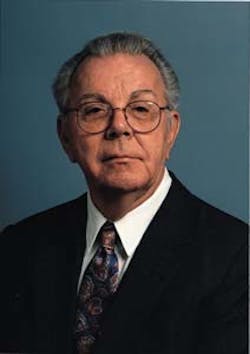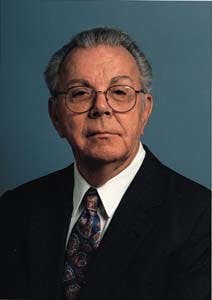LNG imports make strong recovery in 1996; exports increase also
Edward J. SwainLNG imports to the U.S. jumped in 1996 as Algerian base-load plants resumed operations following major revamps. Exports from Alaska to Japan grew by nearly 4% over 1995.
Consultant
Houston
Total LNG imports to the U.S. in 1996 were 40.27 bcf compared to 17.92 bcf in 1995, an increase of 124.8%.
Algeria supplied 35.32 bcf; Abu Dhabi, 4.95 bcf. About 82.3% of the imported LNG was received at Distrigas Corp.'s terminal north of Boston. The remaining LNG was received at the Pan National terminal in Lake Charles, La.
LNG imports during 1995 fell to such a low level not because of depressed U.S. demand but because of limited supply. Algeria's state-owned oil and gas company Sonatrach was the sole supplier of LNG to the U.S. before to 1996. In 1994, it started a major renovation project to restore its LNG plants to their original capacities. This project resulted in LNG-export curtailments to all of its customers, including Distrigas and Pan National.
As the renovations of certain facilities are completed, Sonatrach will increase its LNG exports.
In 1996, as each LNG plant came back on stream, LNG shipments to the Distrigas terminal increased. Also, Sonatrach's shipments to Pan National's terminal increased during the first half of 1997.
First, Algeria's LNG export capacity has been restored to the level that it was prior to the start of its renovation project. Second, the Maghreb-Europe natural-gas pipeline became operational in November 1996. This new 858-mile, 48-in. pipeline is designed to transport Algerian gas to Spain and Portugal via Morocco and the Strait of Gibraltar (OGJ, Dec. 2, 1996, p. 50). The pipeline has freed up more LNG export capacity; Spain currently is Algeria's second largest LNG customer.
Total value of LNG imported to the U.S. was $112.6 million in 1996 at a yearly average price of $2.80/Mcf. The 1995 yearly average price was $2.30/Mcf, showing therefore an imported-LNG price increase of 21.7%.
LNG-receiving terminals
The four existing LNG receiving terminals located along the U.S. East and Gulf Coasts are shown in Table 1 [31,065 bytes].The Distrigas terminal started receiving LNG in 1988 after being shut down in 1987. The quantities of LNG imported through the terminal during the 1992-1996 period and forecast quantities through year 2002 are presented in Table 2 [79,608 bytes]. The data are illustrated in Fig. 1 [49,534 bytes].
The terminal received 33.23 bcf (13 shipments) during 1996. Eleven shipments (28.28 bcf) were received from Algeria and two shipments (4.95 bcf) were received from Abu Dhabi. June was the only month that no shipment of LNG was received at the terminal.
The terminal received 19.55 bcf (eight shipments) during the first half of the year and it is assumed that the total yearly rate for 1997 will be 40.0 bcf.
The terminal primarily serves customers in the New England region. In the past, delivery of LNG from the terminal was mainly by trucks and some distribution by pipeline. New tie-ins to several local major natural-gas pipelines and new industrial contracts, however, have made major delivery changes in Distrigas' operations.
A 15% annual growth rate in LNG shipments is assumed, using the 1997 estimated LNG quantity of 40.0 bcf as a base and extending the forecast period to 2002. Under this growth assumption, the Distrigas terminal is only utilized about 82% in year 2002.
Pan National's LNG terminal at Lake Charles reopened in 1989 and received one shipment of LNG from Algeria in December 1989. The quantities of LNG imported through the terminal 1992-1996 and forecast quantities through 2002 are presented in Table 2. The data are illustrated in Fig. 1.
The terminal received 7.04 bcf (three shipments) during 1996. One shipment per month of LNG was received during April, November, and December. The terminal received 12.80 bcf (six shipments) during the first half of 1997. It is assumed that the total yearly rate for 1997 will be 25.6 bcf.
The terminal is able to move vaporized LNG into many major natural-gas trunk lines serving customers all along the middle and upper East Coast and into the central Great Lakes regions.
In recent years, the natural-gas pipeline serving the growing gas markets in Florida was expanded in deliverable capacity. Vaporized LNG from the Lake Charles terminal was to supply the additional natural-gas demands in the Florida market.
If any additional natural-gas demands have occurred in Florida, gas supplies from offshore gas fields near Mobile have met the demands. New production facilities at the offshore fields and additional distribution systems are being installed. They will supply up to 1.2 bcfd of treated natural gas to serve the Florida markets.
Although a 15% annual growth rate for importing LNG is assumed to take place in the lower Atlantic region, the Lake Charles LNG receiving terminal is only utilized about 27.5% by year 2002.
In early 1993, it was reported that a peak-shaving liquefier would be installed at the Cove Point, Md., LNG terminal and that the entire facility would become an aboveground LNG storage complex. In late 1995, Columbia Gas planned to reopen the Cove Point terminal as a peak-shaving LNG complex using existing storage, gasification, and pipeline facilities. A peak-shaving liquefier will be built to process pipeline gas for liquid storage.
When fully operational, the complex will have 5 bcf (gas-volume equivalent) in storage and a delivery capacity of 1.2 bcfd on a 2-hr notice. The new facilities became operational for the 1995-1996 winter season.1
Southern Natural Gas' LNG terminal at Elba Island, Ga., is unlikely to be in operation through year 2002.
Base-load producers Algerian LNG base-load plants are assumed to supply LNG through 1998 and into mid-1999, the time frame covered by current supply contracts.
Spot purchases of LNG were received into the U.S. during 1996 from sources other than Algeria for only the second time since LNG began to be imported into the U.S. in 1968.
About 4.95 bcf equivalent of LNG was imported from Abu Dhabi during September and November 1996 and was received at Distrigas' terminal. Also, a spot purchase of LNG from Australia was received in May 1997, also at Distrigas' terminal.
These spot purchases indicate that LNG transactions are becoming more flexible and responsive to changes in the world marketplace.
The LNG base-load plant sited in Trinidad is moving ahead as the engineering, procurement, and construction contract was signed in mid-1996. Current schedule calls for the LNG plant to be operational by mid-1999. It appears that LNG output will be marketed into New England and Western European countries such as Portugal and Spain.
The first train of the planned LNG base-load plant in Nigeria is scheduled to be operating in 2000. Of the first train's output, 3% is contracted to Distrigas' U.S. northeast operations. The remaining LNG output is slated for various Western European customers.
Another potential LNG supply source to the U.S. market-Venezuela's Cristobal Colon LNG project-continues to be on hold.
LNG pricing
The projection of LNG entering the U.S. market place does not consider product prices of low and high-cost LNG producers. Some guidance of LNG landing prices, however, is available from Sonatrach's LNG into Distrigas and Pan National terminals which are presented in Table 3 [61,949 bytes].One needs to compare these prices against the price history of natural gas being purchased by electric utilities and industrial customers in the states where the LNG terminals are located. These natural-gas prices are presented in Table 3. A review of the price history of the two customers-electric utilities and industrial-can estimate in what markets imported LNG can be utilized as a base-load fuel.
When any new Atlantic Rim LNG producer comes online in the late 1990s or early 2000s, will U.S. natural-gas prices be high enough to attract new supplies of LNG? Or, will Western European customers be the home for the new supplies of LNG?
A major increase in U.S. natural-gas prices is needed to aid in attracting any new LNG producer. Higher natural gas prices, however, could bring more gas in from Canada.
Exports
The Phillips Petroleum Co. and Marathon Oil Co. joint-venture operation at the Port Nikiski base-load LNG plant on Cook Inlet of southern Alaska exported 67.65 bcf to Tokyo Gas Ltd. and Tokyo Electric Power Co. Inc., Yokohama, during 1996. The 1996 LNG shipments represented an increase of 3.6% over the 1995 export volume of 65.28 bcf. An expansion of the LNG facilities was performed by Bechtel during 1992-1993, making the increase in exports possible from the past average level of 53 bcf.Total LNG sales revenue to Phillips and Marathon was $246.6 million in 1996, an increase of 10.6% over the $222.9 million received during 1995. The average selling price increased 7.0% from $3.41/Mcf in 1995 to $3.65/Mcf in 1996.
The 5-year shipping-price history (1992-1996; $/MMBTU) of LNG leaving Port Nikiski is as follows: 1992, $3.43; 1993, $3.34; 1994, $3.18; 1995, $3.41; and 1996, $3.65).
The Japanese have been putting pressure on all their LNG suppliers to reduce the purchase price of LNG. In 1996 six countries supplied LNG to Japan: Australia, Brunei, Indonesia, Malaysia, U.A.E., and the U.S.
Indonesia was the major supplier at 40.0%; the U.S. supplied only 2.8% of the LNG imported into Japan. As energy resources imported into Japan are price-indexed to world crude-oil prices and since world crude-oil prices increased during 1996, the price of LNG imported into Japan increased in 1996, as well.
The Phillips/Marathon joint venture signed an agreement with Tokyo Gas Ltd. and Tokyo Electric Power Co. Inc. in mid-1988 to continue LNG sales through 2004. The joint venture then signed, in 1967, the initial contract that expired in 1989 with the two Tokyo utilities. Shipment from Cook Inlet to Tokyo began in 1969.
Under the new contract, two new LNG carriers (87,500 cu m each) will deliver about 64 bcf/year of LNG in 17 trips at maximum demand rate. Delivery at this rate was started in 1993. A review of the actual and forecast quantities of LNG shipped from Port Nikiski (Table 4 [53,601 bytes]; Fig. 2 [52,115 bytes]) reveals that the contract quantity of 64 bcf/year was exceeded in 1995 and 1996.
Based on the first 6 months' deliveries in 1997, the LNG quantity exported to Japan for the full year of 1997 will be about 60.1 bcf. There is a mild slowdown in the Japanese economy requiring less power generation. As the economy picks up in the coming years, so will the power requirements and, in turn, greater LNG needs.
Phillips operates the LNG plant and Marathon the LNG carriers. Sales and facilities' interests are split-Phillips 70%, Marathon 30%. The feed gas to the LNG unit is provided by Phillips and Marathon from gas fields in the upper Cook Inlet area.
It is assumed that the Yukon Pacific LNG project will not affect the export of LNG from Alaska to Japan within the time period of year 2002.
Reference
1. "Cove Point: A Step Back Into The LNG Business," American Gas Journal, December 1995/ January 1996.The Author
Edward J. Swain is an independent consultant in Houston. He is retired from Bechtel Corp., where he was a process planning engineer. Before joining Bechtel, he worked for UOP and Velsicol Chemical Corp. He has a BS in chemical engineering and an MS in business and engineering administration, both from the Illinois Institute of Technology, Chicago.
Copyright 1997 Oil & Gas Journal. All Rights Reserved.

